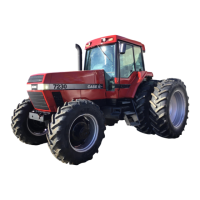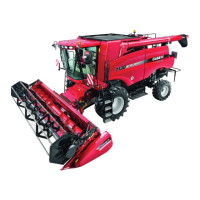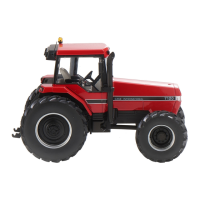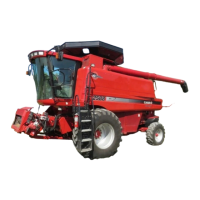6 - FIELD OPERATION
227
“Quick Stop” Problem Diagnosis
This procedure allows you to inspect the inside of
your Combine as if it was in operation. Because the
machine must be stopped for inspection, there will be
some major differences between the conditions
inspected and those that exist during operation. Even
with these obvious limitations the procedure can be
an extremely useful diagnostic tool. To perform a
“quick stop” follow this procedure:
1. Select a relatively level area of the field where
the crop is reasonably uniform and
representative. Use the highest transmission
gear in which you can achieve the normal
operating speed, i.e. use second gear if possible.
2. While operating the Combine in a normal, steady
manner, execute Steps A, B and C in rapid
sequence.
A. With your right hand, move the engine
speed control to the slow idle position.
B. With your left hand, move the propulsion
control lever to the fastest forward position.
C. Apply both brake pedals with the pedals
locked together.
Do not turn off the key switch until after the “quick
stop”.
NOTE: Although this may appear to be abusive to
the Combine, it really only uses the brakes to stop
the separator quickly. Without the external braking
effort, the momentum of the rotor would continue to
drive the separator to a coasting stop. In a successful
“quick stop” the Combine must stop within ten feet.
IMPORTANT: Never use the “quick stop” procedure
when operating conditions are such that restarting
the rotor might be difficult.
3. Immediately after making the “quick stop”, move
the separator drive and feeder clutch switches to
the OFF position. Return the propulsion control
lever to the stop position, restart the engine and
allow it to cool to a safe shutdown temperature.
Then stop the engine, set the parking brakes and
remove the key from the switch.
4. Open the Left front trim doors and remove the
Left side shields from the concave and grate
areas.
5. Inspect the concaves for indications of plugging
or other problems.
6. Check the material in the auger bed for signs of
incomplete threshing, kernel damage or other
abnormal conditions.
7. Agitate the crop material inside the rotor in the
grate area. If there are loose kernels near the
rear of the grate area, this probably indicates
excessive rotor losses. On the other hand,
relatively few kernels near the front of the grate
area would suggest a reserve of separating
capacity.
8. Check the distribution of material on the grain
pan and chaffer sieve. The load distribution on
the chaffer sieve should be inspected from the
rear as well as the left hand inspection area.
9. Lower the tailings auger trough door. Inspect the
load and load distribution on the shoe sieve.
Check the type and amount of material in the
tailings auger trough.
10. Make sure crop material flow is proper in the
header, feeder house and elevators.
11. Using all the information available, proceed with
adjustments or corrections as listed in the
troubleshooting charts.
12. Replace shields, close the tailings auger trough
door, close the trim doors and recheck to be sure
the machine is ready to be restarted safely.

